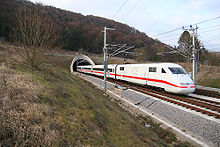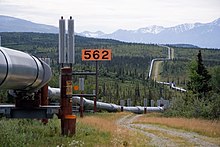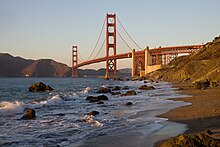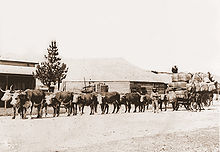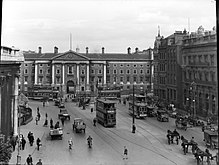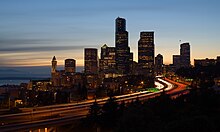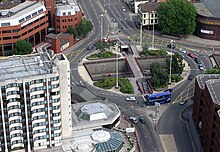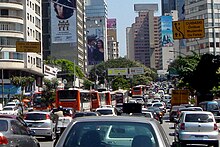
Rail transport is a means of transport using wheeled vehicles running in tracks, which usually consist of two parallel steel rails. Rail transport is one of the two primary means of land transport, next to road transport. It is used for about 8% of passenger and freight transport globally, thanks to its energy efficiency and potentially high speed.

A train is a series of connected vehicles that run along a railway track and transport people or freight. Trains are typically pulled or pushed by locomotives, though some are self-propelled, such as multiple units. Passengers and cargo are carried in railroad cars, also known as wagons. Trains are designed to a certain gauge, or distance between rails. Most trains operate on steel tracks with steel wheels, the low friction of which makes them more efficient than other forms of transport.
The vast majority of passenger travel in the United States occurs by automobile for shorter distances and airplane or railroad for longer distances. Most cargo in the U.S. is transported by, in descending order, railroad, truck, pipeline, or boat; air shipping is typically used only for perishables and premium express shipments. Transportation is the largest source of greenhouse gas emissions in the United States.

Transportation engineering or transport engineering is a sub discipline of Civil engineering specialized in the application of technology and scientific principles to the planning, functional design, operation and management of facilities for any mode of transportation in order to provide for infrastructure for safe, efficient, rapid, comfortable, convenient, economical, and environmentally compatible movement of people and goods transport.

Transport in Europe provides for the movement needs of over 700 million people and associated freight.

In transportation, freight refers to goods conveyed by land, water or air, while cargo refers specifically to freight when conveyed via water or air. In economics, freight refers to goods transported at a freight rate for commercial gain. The term cargo is also used in case of goods in the cold-chain, because the perishable inventory is always in transit towards a final end-use, even when it is held in cold storage or other similar climate-controlled facilities, including warehouses.
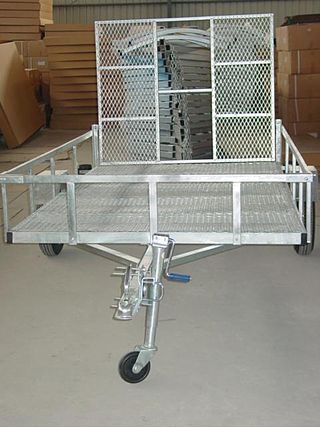
A trailer is an unpowered vehicle towed by a powered vehicle. It is commonly used for the transport of goods and materials.

Intermodal passenger transport, also called mixed-mode commuting, involves using two or more modes of transportation in a journey. Mixed-mode commuting is often used to combine the strengths of various transportation options. A major goal of modern intermodal passenger transport is to reduce dependence on the automobile as the major mode of ground transportation and increase use of public transport. To assist the traveller, various intermodal journey planners such as Rome2rio and Google Transit have been devised to help travellers plan and schedule their journey.

Rail freight transport is the use of railroads and trains to transport cargo as opposed to human passengers.
Mode of transport is a term used to distinguish between different ways of transportation or transporting people or goods. The different modes of transport are air, water, and land transport, which includes rails or railways, road and off-road transport. Other modes of transport also exist, including pipelines, cable transport, and space transport. Human-powered transport and animal-powered transport are sometimes regarded as their own mode, but never fall into the other categories. In general, transportation is used for moving of people, animals, and other goods from one place to another. Means of transport, on the other hand, refers to the transport facilities used to carry people or cargo according to the chosen mode. Each mode of transport has a fundamentally different technological solution, and some require a separate environment. Each mode has its own infrastructure, vehicles, transport operators and operations.Transportations helps in the better utilisation of the resources of the backyard areas by linking them with the more advanced areas. It aids in the process of industrialisation and urbanization.

A dual-mode vehicle (DMV) is a vehicle that can operate on conventional road surfaces as well as a railway track or a dedicated track known as a guideway. The development of these vehicles started together with personal rapid transport systems in the 1950s or even earlier.
The following outline is provided as an overview of and topical guide to transport:
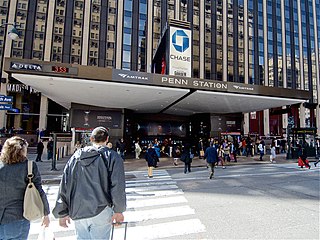
A transport hub is a place where passengers and cargo are exchanged between vehicles and/or between transport modes. Public transport hubs include railway stations, rapid transit stations, bus stops, tram stops, airports and ferry slips. Freight hubs include classification yards, airports, seaports and truck terminals, or combinations of these. For private transport by car, the parking lot functions as a unimodal hub.

Transport geography or transportation geography is a branch of geography that investigates the movement and connections between people, goods and information on the Earth's surface.

A passenger train is a train used to transport people along a railroad line. These trains may consist of unpowered passenger railroad cars hauled by one or more locomotives, or may be self-propelled; self propelled passenger trains are known as multiple units or railcars. Passenger trains stop at stations or depots, where passengers may board and disembark. In most cases, passenger trains operate on a fixed schedule and have priority over freight trains.
Transport or transportation is the intentional movement of humans, animals, and goods from one location to another. Modes of transport include air, land, water, cable, pipelines, and space. The field can be divided into infrastructure, vehicles, and operations. Transport enables human trade, which is essential for the development of civilizations.
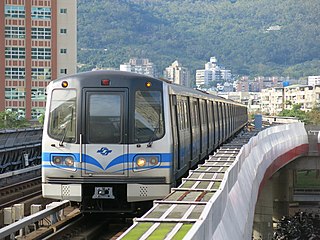
Public transport is a system of transport for passengers by group travel systems available for use by the general public unlike private transport, typically managed on a schedule, operated on established routes, and that may charge a posted fee for each trip. There is no rigid definition of which kinds of transport are included, and air travel is often not thought of when discussing public transport—dictionaries use wording like "buses, trains, etc." Examples of public transport include city buses, trolleybuses, trams and passenger trains, rapid transit and ferries. Public transport between cities is dominated by airlines, coaches, and intercity rail. High-speed rail networks are being developed in many parts of the world.

Transport in the Union of Soviet Socialist Republics (USSR) was an important part of the nation's economy. The economic centralisation of the late 1920s and 1930s led to the development of infrastructure at a massive scale and rapid pace. Before the Soviet Union's collapse in 1991, there were a wide variety of modes of transport by land, water and air. However, because of government policies before, during and after the Era of Stagnation, investments in transport were low. By the late 1970s and early 1980s Soviet economists were calling for the construction of more roads to alleviate some of the strain from the railways and to improve the state budget. The civil aviation industry, represented by Aeroflot, was the largest in the world, but inefficiencies plagued it until the USSR's collapse. The road network remained underdeveloped, and dirt roads were common outside major cities. At the same time, the attendance of the few roads they had were ill-equipped to handle this growing problem. By the late-1980s, after the death of Leonid Brezhnev, his successors tried, without success, to solve these problems. At the same time, the automobile industry was growing at a faster rate than the construction of new roads. By the mid-1970s, only 0.8 percent of the Soviet population owned a car.
Urban freight distribution is the system and process by which goods are collected, transported, and distributed within urban environments. The urban freight system can include seaports, airports, manufacturing facilities, and warehouse/distribution centers that are connected by a network of railroads, rail yards, pipelines, highways, and roadways that enable goods to get to their destinations.
The following outline is provided as an overview of and topical guide to land transport:



